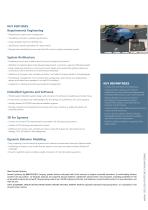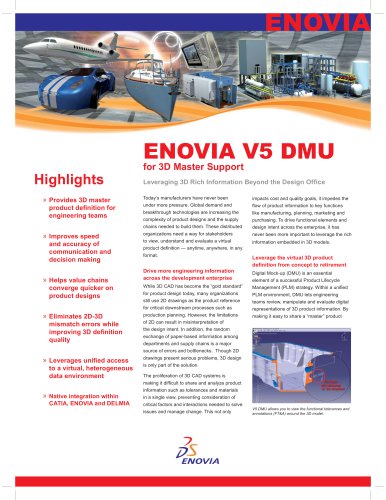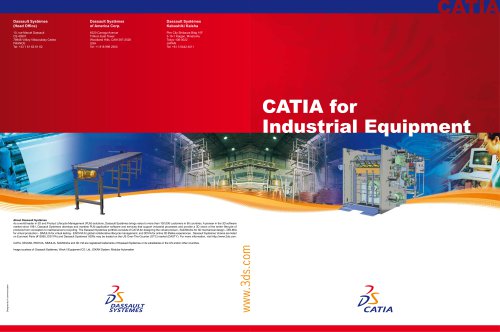
カタログの抜粋

SYSTEMS ENGINEERING FOR PRODUCT DEVELOPMENT In a global competitive environment, regardless of your industry, these are some of the most intense pressures you are facing for any new product development. Systems Engineering is paramount for addressing these challenges. It helps comprehend, organize, and manage the complexity of product development throughout its lifecycle from concept to production to operation, starting with the early stages including answering requirements, defining a product’s functions, and establishing its technical architecture. To successfully complete the development of a product, both technical and business aspects such as performance, cost, schedule, sourcing, manufacturing, and disposal must be considered. Systems Engineering integrates multiple domains and brings together contributors from diverse technical disciplines to provide a high-level, comprehensive definition of a product. This interdisciplinary approach looks at the product as a whole, with all components working together as a single unit. Leveraging its long-time experience as a leader in Product Lifecycle Management (PLM), Dassault Systèmes has introduced a unique RFLP approach as the cornerstone of its Systems Engineering solutions. This approach provides a comprehensive, collaborative definition of a product across its different views from Requirements, Functional (targeted services), Logical (technology), and Physical (implementation) design. DS solutions for Systems Engineering centralize all development efforts around a unified, collective product definition, and bring the various disciplines together on a common platform to foster collaboration and innovation. Moreover, the components from multiple disciplines (such as mechanics, thermodynamics, and electricity including electronics) as well as the numerous interactions between them are modeled on a common platform to enable dynamic simulation of the complete system via a virtual prototype. The behavior of the product in operation is thoroughly assessed while various design alternatives are tested very early on. HOW CAN YOU MANAGE INCREASING PRODUCT AND PROCESS COMPLEXITY? COMPLIANCE TO EVER GROWING STRINGENT INDUSTRY REGULATIONS? INCREASING PRESSURE TO DELIVER PRODUCTS FASTER? TRACEABILITY FROM CUSTOMER NEEDS AND INITIAL REQUIREMENTS TO FINAL PRODUCT VALIDATION?
カタログの1ページ目を開く
KEY FEATURES Requirements Engineering • Requirements capture and management • Traceability matrices to validate specifications • Impact analysis reports to identify risks • Specification reports generation for requirements • Requirement traceability across more than 60 common systems engineering tools System Architecture • odeling environment to define the functional and logical architecture M • Definition of implementation links between Requirement, Functional, Logical and Physical objects • ssign behaviors (discrete or continuous) to each object and simulate the global architecture, A...
カタログの2ページ目を開くカタログアーカイブ
-
CST STUDIO SUITE
6 ページ
-
GEOVIA WHITTLE
4 ページ
-
GEOVIA MINESCHED
4 ページ
-
GEOVIA MINEX
4 ページ
-
GEOVIA GEMS
4 ページ
-
GEOVIA SURPAC
4 ページ
-
SIMPACK
2 ページ
-
DELMIA
11 ページ
-
EXALEAD ONECALL
4 ページ
-
CST STUDIO SUITE 2017
32 ページ
-
WHITTLE
4 ページ
-
geovia
4 ページ
-
geovia minex
4 ページ
-
SOLIDWORKS COMPOSER
4 ページ
-
SOLIDWORKS PREMIUM
6 ページ
-
SOLIDWORKS VISUALIZE
4 ページ
-
SOLIDWORKS PDM
4 ページ
-
EXALEAD ONEPART
4 ページ
-
CATIA SHEET METAL
2 ページ
-
fe-safe ® DATA SHEET
4 ページ
-
fe-safe
6 ページ
-
CATIA Machining
4 ページ
-
CATIA for yacht
4 ページ
-
CATIA PLM EXPRESS
10 ページ
-
ENOVIA V6
32 ページ
-
Isight
6 ページ
-
Abaqus
6 ページ
-
SIMULIA V6R2013x
7 ページ
-
ENOVIA-V6R2013x
12 ページ
-
catia_electrical
8 ページ
















































